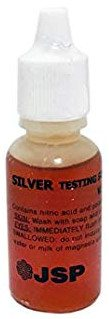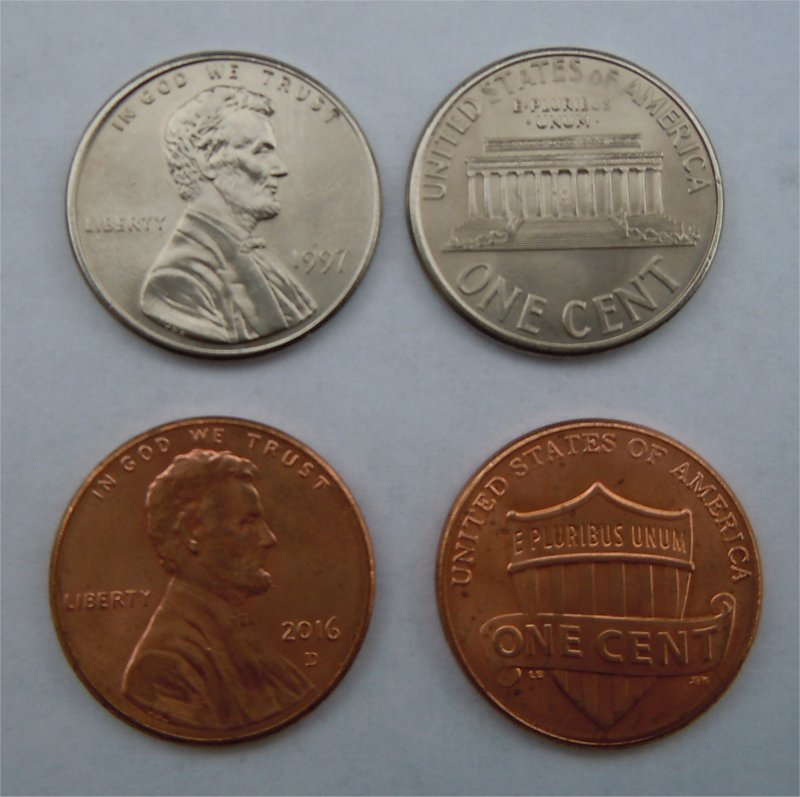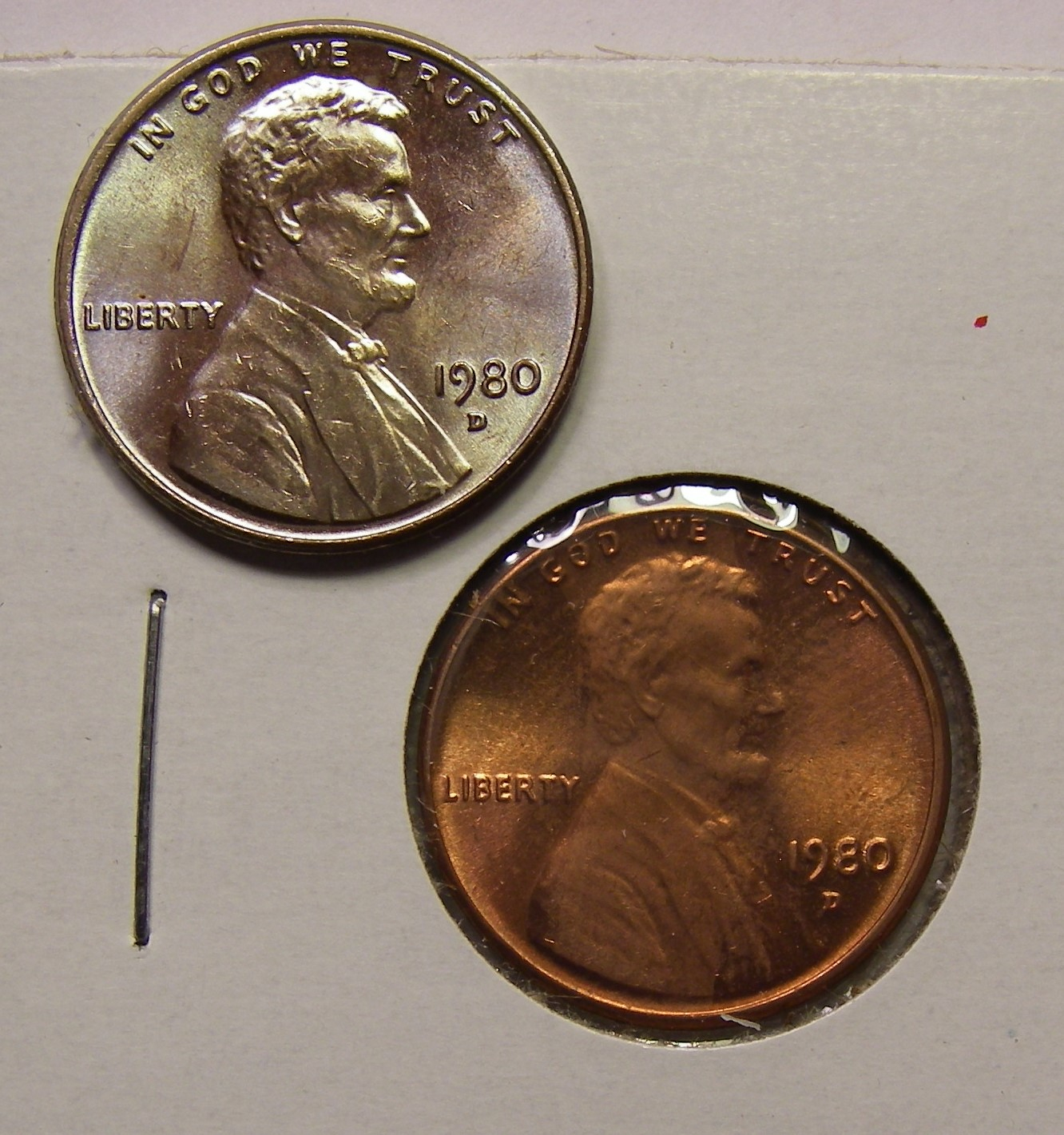I am not sure why we are making this 100 times harder than it needs to be. Very simple:
Weigh all 50 (or 30 or whatever) at once. If possible, don't use that bake scale. Use a postage scale or something.
Take that number and divide by the number of coins.
If it is 2.50 or greater, they are plated or otherwise altered.
If it is 2.45, they are unplated.
It's possible the bake scale will not be sensitive enough if it only shows 3 digits. Depends on sample size.
Explanation: yes one cannot tell plated from unplated by one coin. However, he has many. Even assuming 30 and assuming the mint is very bad at their job (they are not) =
.13g tolerance (allowed range for cents)
Max sd of .043g (being very conservative here)
@Downtown1974 Your original though about your cent being plated was correct. Its way too shiny and overweight. It would have corroded sitting in a box of random stuff. Zinc is very reactive to just about everything.
Successful BST with ad4400, Kccoin, lablover, pointfivezero, koynekwest, jwitten, coin22lover, HalfDimeDude, erwindoc, jyzskowsi, COINS MAKE CENTS, AlanSki, BryceM
Very interesting.
I would not damage any of these coins to see what the composition is.
Did a google search and this is what I found.
>
How to test for silver.
The most accurate test, it will require you to buy test acid for silver. The acid itself is usually a mixture of nitric acid and muriatic acid. So be careful with the acid solution and make sure to wear gloves and eye protection. Some people try to save money by using vinegar instead of acid but vinegar won't give you accurate results.
Best of luck.
Wayne
@Aercus said:
I am not sure why we are making this 100 times harder than it needs to be. Very simple:
Weigh all 50 (or 30 or whatever) at once. If possible, don't use that bake scale. Use a postage scale or something.
Take that number and divide by the number of coins.
If it is 2.50 or greater, they are plated or otherwise altered.
If it is 2.45, they are unplated.
It's possible the bake scale will not be sensitive enough if it only shows 3 digits. Depends on sample size.
Explanation: yes one cannot tell plated from unplated by one coin. However, he has many. Even assuming 30 and assuming the mint is very bad at their job (they are not) =
.13g tolerance (allowed range for cents)
Max sd of .043g (being very conservative here)
.043g/sqrt (30)
Standard error of the mean no more than .01g.
The problem is that there is a weight tolerance and his scale is not that accurate, even for 30
All comments reflect the opinion of the author, even when irrefutably accurate.
@Aercus said:
I am not sure why we are making this 100 times harder than it needs to be. Very simple:
Weigh all 50 (or 30 or whatever) at once. If possible, don't use that bake scale. Use a postage scale or something.
Take that number and divide by the number of coins.
If it is 2.50 or greater, they are plated or otherwise altered.
If it is 2.45, they are unplated.
It's possible the bake scale will not be sensitive enough if it only shows 3 digits. Depends on sample size.
Explanation: yes one cannot tell plated from unplated by one coin. However, he has many. Even assuming 30 and assuming the mint is very bad at their job (they are not) =
.13g tolerance (allowed range for cents)
Max sd of .043g (being very conservative here)
.043g/sqrt (30)
Standard error of the mean no more than .01g.
The problem is that there is a weight tolerance and his scale is not that accurate, even for 30
I took that into account and suggested a postal scale for that reason.
@Aercus said:
I am not sure why we are making this 100 times harder than it needs to be. Very simple:
Weigh all 50 (or 30 or whatever) at once. If possible, don't use that bake scale. Use a postage scale or something.
Take that number and divide by the number of coins.
If it is 2.50 or greater, they are plated or otherwise altered.
If it is 2.45, they are unplated.
It's possible the bake scale will not be sensitive enough if it only shows 3 digits. Depends on sample size.
Explanation: yes one cannot tell plated from unplated by one coin. However, he has many. Even assuming 30 and assuming the mint is very bad at their job (they are not) =
.13g tolerance (allowed range for cents)
Max sd of .043g (being very conservative here)
.043g/sqrt (30)
Standard error of the mean no more than .01g.
The problem is that there is a weight tolerance and his scale is not that accurate, even for 30
I took that into account and suggested a postal scale for that reason.
Or perhaps he could make use of a jeweler's, coin dealer's or pharmacist's scale.
At this point, weighing the coins makes more sense to me than testing one or more of them and/or continuing to speculate, without adequate information.
Mark Feld* of Heritage Auctions*Unless otherwise noted, my posts here represent my personal opinions.
I think somebody mentioned a hand held XRF earlier. The XRF penetrates deep enough to go through most plating. If you see appreciable Copper, it's plated. No copper, then its an unplated planchet. Find a coin shop, jeweler, or buy gold place and take a couple to confirm the results.
Another way to see if it's an unplated planchet is to check for luster on the surface. However, if you're new to the hobby, it may not be obvious.
OK - I think the mystery is solved about the pennies ....
Below is a picture I took outside - The silver colored and regular
pennies
I took a couple of the pennies to a PCGS authorized dealer here in
Springfield, Ma - The Coin Exchange https://gold-silvershop.com/
They weighed the penny against a regular penny - both weighed 2.5
They told me the pennies we plated, for what reason, they don't know
I do appreciated all the input on these pennies as I am a novice in the
area of coin collecting. I found a couple more coins in a box in my safe
I do have a couple questions on - will post in another thread .....
"They weighed the penny against a regular penny - both weighed 2.5"
If the weight was the same there is a chance yours have "toned" that color for one of many reasons.
This one is silver because of high heat and is not plated.
Comments
I would really handle them as little as possible. If they are unplated the zinc will go bad in a hurry if handled.
Here’s mine. It’s been in box of miscellaneous stuff that really had no home in my collection.
I am not sure why we are making this 100 times harder than it needs to be. Very simple:
Weigh all 50 (or 30 or whatever) at once. If possible, don't use that bake scale. Use a postage scale or something.
Take that number and divide by the number of coins.
If it is 2.50 or greater, they are plated or otherwise altered.
If it is 2.45, they are unplated.
It's possible the bake scale will not be sensitive enough if it only shows 3 digits. Depends on sample size.
Explanation: yes one cannot tell plated from unplated by one coin. However, he has many. Even assuming 30 and assuming the mint is very bad at their job (they are not) =
.13g tolerance (allowed range for cents)
Max sd of .043g (being very conservative here)
.043g/sqrt (30)
Standard error of the mean no more than .01g.
Aercus Numismatics - Certified coins for sale
@Downtown1974 Your original though about your cent being plated was correct. Its way too shiny and overweight. It would have corroded sitting in a box of random stuff. Zinc is very reactive to just about everything.
Successful BST with ad4400, Kccoin, lablover, pointfivezero, koynekwest, jwitten, coin22lover, HalfDimeDude, erwindoc, jyzskowsi, COINS MAKE CENTS, AlanSki, BryceM
Very interesting.

I would not damage any of these coins to see what the composition is.
Did a google search and this is what I found.
>
How to test for silver.
The most accurate test, it will require you to buy test acid for silver. The acid itself is usually a mixture of nitric acid and muriatic acid. So be careful with the acid solution and make sure to wear gloves and eye protection. Some people try to save money by using vinegar instead of acid but vinegar won't give you accurate results.
Best of luck.
Wayne
Kennedys are my quest...
The problem is that there is a weight tolerance and his scale is not that accurate, even for 30
All comments reflect the opinion of the author, even when irrefutably accurate.
@WAYNEAS it could be plated with zinc or even rubbed with mercury.
Successful BST with ad4400, Kccoin, lablover, pointfivezero, koynekwest, jwitten, coin22lover, HalfDimeDude, erwindoc, jyzskowsi, COINS MAKE CENTS, AlanSki, BryceM
I took that into account and suggested a postal scale for that reason.
Aercus Numismatics - Certified coins for sale
You have 30. So send one to Fred Weinberg and see what he says.
Or perhaps he could make use of a jeweler's, coin dealer's or pharmacist's scale.
At this point, weighing the coins makes more sense to me than testing one or more of them and/or continuing to speculate, without adequate information.
Mark Feld* of Heritage Auctions*Unless otherwise noted, my posts here represent my personal opinions.
Small digital scale that's graduated in tenths of a grams can be had for about $10-$15.
I think somebody mentioned a hand held XRF earlier. The XRF penetrates deep enough to go through most plating. If you see appreciable Copper, it's plated. No copper, then its an unplated planchet. Find a coin shop, jeweler, or buy gold place and take a couple to confirm the results.
Another way to see if it's an unplated planchet is to check for luster on the surface. However, if you're new to the hobby, it may not be obvious.
Not accurate enough. A regular cent is 2.50 g. A copper-less is 2.45g. They are likely to both read 2.5g
You can get 0.01 grams for $15 to $20, however.
All comments reflect the opinion of the author, even when irrefutably accurate.
That's actually really cool!
My YouTube Channel
OK - I think the mystery is solved about the pennies ....
Below is a picture I took outside - The silver colored and regular
pennies
I took a couple of the pennies to a PCGS authorized dealer here in
Springfield, Ma - The Coin Exchange
https://gold-silvershop.com/
They weighed the penny against a regular penny - both weighed 2.5
They told me the pennies we plated, for what reason, they don't know
I do appreciated all the input on these pennies as I am a novice in the
area of coin collecting. I found a couple more coins in a box in my safe
I do have a couple questions on - will post in another thread .....
Al / USMC

Disabled Vietnam Veteran
@USMC at least you know they are plated now and won't waste any money on certification.
Successful BST with ad4400, Kccoin, lablover, pointfivezero, koynekwest, jwitten, coin22lover, HalfDimeDude, erwindoc, jyzskowsi, COINS MAKE CENTS, AlanSki, BryceM
"They weighed the penny against a regular penny - both weighed 2.5"
If the weight was the same there is a chance yours have "toned" that color for one of many reasons.

This one is silver because of high heat and is not plated.